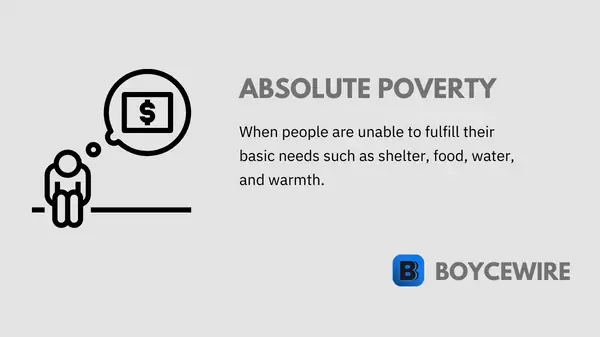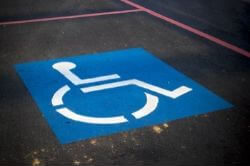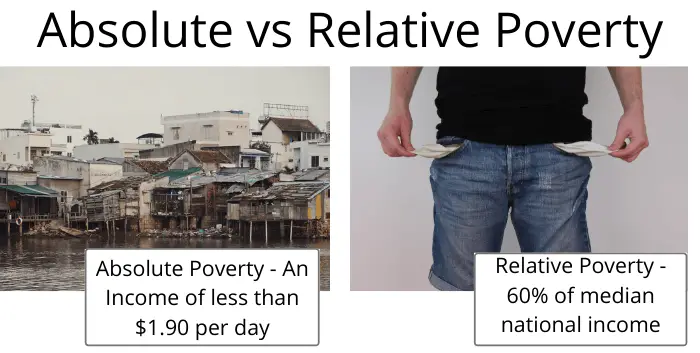Absolute Poverty: Definition, Causes & Examples

What is Absolute Poverty
Absolute poverty is where an individual is unable to meet their immediate needs. In other words, they are unable to obtain basic necessities such as shelter, water, food and warmth. This is different from a similar term, relative poverty, which is where individuals are poor by comparison to other members of society.
The World Bank uses absolute poverty as its default definition of ‘poverty’. It defines it as anyone living on less than $1.90 a day. This is to distinguish a uniform measure of poverty throughout the world and identify serious cases of poverty. For example, someone in the US would have to earn less than $13,000 per year to fall into relative poverty. However, that works out at $35 per day, well in excess of the $1.90 threshold that the World Bank sets to define absolute poverty.
Key Points
- Absolute poverty is defined by the World Bank as having an income below $1.90 per day.
- Absolute poverty differs from relative poverty in the fact that those in absolute poverty are unable to meet their daily needs of food and water. Those in relative poverty are poor in comparison to the rest of the country.
The terminology of absolute poverty only covers basic needs. We may often hear that poverty is at an all-time high or poverty is increasing. However, this often refers to relative poverty which is based on average income levels of a nation. By contrast, absolute poverty refers to the absence of any human needs such as food or water – think of Sub-Saharan Africa for example.
Causes of Absolute Poverty
When we talk of absolute poverty, we may associate it with under-nourished people from third world nations. This is very different from the relative poverty we see in developed nations such as the US, where the poor still have access to food, water, and shelter. As such, the causes of absolute poverty are very different and generally apply to poorer nations that have an absence of investment and infrastructure. Some examples include:
1. Inadequate Access to Necessities
Inadequate access is particularly prevalent in first and developing world nations. Simply put, it is difficult to find food, water, or shelter. This disproportionately affects those who live in rural areas. They live far away from civilisation, so face greater challenges to satisfy their basic needs.

For instance, the nearest store may be miles away, if not, non-existent. Some rural communities are self-reliant and therefore do not earn a wage but are self-dependant. In turn, this can result in absolute poverty if they are unable to source their immediate needs.
2. Availability of Jobs
In the developed world, the welfare state has largely prevented the lack of available jobs causing absolute poverty, even though it may lead to relative poverty.
With that said, many countries through Africa and the rest of the developing world have faced years of war, colonialism and plunder. Without private property rights, many of these nations resources have been depleted. Businesses are few and far between and foreign investment is discouraged due to corrupt regimes. This restricts the amount of job creation, meaning individuals have to solely rely on themselves for their basic needs.
3. Inadequate Advances in Agriculture
Part of the cause of absolute poverty is simply the lack of advancement in agriculture. If we look at developed nations today, their development stems from such advances that allowed workers to move away from subsistence living. Due to agricultural advances, food became more plentiful, meaning there was more than enough food to go around. In turn, this freed up workers to produce other goods and services within the economy.
As farmer’s output increase, there was too much competition and supply, and not enough demand. The nation’s people were well supplied for, which drove farmers out of the market. Yet it created new avenues for employment, as basic needs were met and workers were freed from toiling the farm.

These advancements in agriculture were driven by increasing levels of education, strong private property rights, and an ease of doing business. Factors that are lacking in many developing nations today. As a result, a nation that is unable to sufficiently feed itself is going to face greater levels of absolute poverty.
4. Movement of Industry
As industries come and go, so too do the jobs they create. We have now moved towards a post-industrialised society whereby we rely on services rather than manufacturing and production. As a result, we have seen the destruction of towns and cities that relied on industry to provide employment.
Factories closed and industry shifted towards services and metropolitan areas. Those who were left behind had to create a life around their skills and expertise. However, the new reality is that millions have either been left without a job, or left the workforce completely.
For many, it is incredibly difficult to move to where jobs are more plentiful, particularly in older age. In many cases, we see people living in absolute poverty due to the absence of jobs. Unable or unwilling to move, they are left to face an existence with a souless local economy.
5. Conflict
War has historically been one of the leading causes of absolute poverty. It destroys capital, trade, investment, and supply chains. Looking at World War Two, it was the costliest war in history. Hundreds of thousands of Russians starved in the siege of Leningrad. That was just one part of the War which is estimated to have cost between 35 to 60 million lives.

Even in small scale conflicts in Africa, wars led to plunder and destruction. For example, natural resources are depleted and become irrecoverable as property rights are abused or are non-existant. This leads a nations people with little in the way of natural resources or a source of income. The very source by which they could achieve a sustainable source of income has been destroyed through years of war and plunder.
6. Poor Education
A nation that is poorly educated is unable to read or write, so communication becomes that much more difficult. Even in nations with a good educational system such as the US, over 4 percent of the population cannot read or write.
Without such basic skills, it is virtually impossible to find a job in a developed nation. Even in developing nations such as India, the necessity to even read and write can be the difference between absolute poverty or a comfortable life.

A report from UNESCO concludes such. It stated that world poverty would be cut in half if all adults were able to complete secondary education. However, without the investment from government, it makes this an unfeasible target.
The UNESCO report joins a number of other studies that have highlighted the link between education and poverty, but what is the logic behind this?
An education is not necessarily just reading and writing; although it is a major part. It is also about learning new ideas, and techniques that can help with everyday life. As such, an education can help specifically with certain skills. For instance, geography and the sciences may assist with agriculture. Or, agricultural techniques may assist a nations people to become more productive, allowing its farmers to move into other industries.
7. Lack of Infrastructure
Without roads, hospitals, railways, and the like, the value of a persons output is significantly restricted. For example, a farmer may be able to produce far in excess of their own consumption.

They are then able to sell some at market. However, without the accessibility of roads and motorways, they are unable to do such. The nearest market may be 10 miles away, which is easily drivable, but a far more strenuous walk with a cart load of produce. This presents a significant barrier that would otherwise allow the farmer a better way of life.
Furthermore, the lack of schools means the ability to educate the population is reduced. As discussed before, a lack of education has been proven to correlate with lower levels of absolute poverty. Those who cannot read and write find it harder to capture and pass on information and knowledge, which stems economic advancement.
8. Mental Health
Mental health issues are a significant cause of absolute poverty in both the developed and the developing world. It can impact on a person’s ability to work, with varying degrees of severity. For example, it may impact an individual’s ability to undertake everyday tasks, thereby presenting a need to rely on others.
When those with mental health issues are unable to get out of bed, they are equally unable to go to work. And without work, many will fall into absolute poverty which only makes their situation worse.
Absolute Poverty Examples
Homelessness
For one reason or another, both those in developed and the developing world end up homeless. Generally, the most cited reasons are mental health issues, drug abuse, or a combination. Either way, those who are homeless are inevitably more likely to suffer from absolute poverty.

Homeless people are extremely vulnerable, particularly due to the prevalence of mental health difficulties. For example, statistics in the UK show that mental health illness among the homeless is as high as 80 percent.
When individuals have difficulties in the daily activities of life, they may be unable to get out of bed or even feed themselves. What we see as a result is the inability to work, and consequently, a decline into absolute poverty.
Disabled
Another example of absolute poverty are those who are disabled. A disability can range from severely debilitating to mildly, each with a different impact on an individual’s ability to work or find work. In the extreme, someone who has lost their arms and legs faces an almost impossible task of finding work.

What we see as a result is that those with a disability have a greater risk of falling into absolute poverty. First of all, they can be significantly limited in the jobs they can take. For example, any form of manual labor is out of the question for someone without arms.
Second of all, they may face discrimination. Firms must make the necessary arrangements to cater for the disabled, which can impose additional costs. In addition, they may face a stigma which questions their productivity.
All of this makes in more difficult for disabled individuals to obtain a job. As a result, their chances of falling into absolute poverty increase dramatically.
South Sudan
South Sudan has one of the highest rates of absolute poverty in the world, at around 80 percent.
The reason being the constant wars the nation has faced; both civil and regional.
It has faced constant destruction over many decades, which has inevitably destroyed what existing capital the country had. People have to live in fear of their life, with food, roads, and water cut off for many.
Absolute Poverty vs Relative Poverty
Absolute poverty refers to a situation by which the individual is unable to meet their basic needs such as food and water. The World bank quantifies this by using a $1.90 per day threshold which is worked out using Purchasing Power Parity.
In other words, it is adjusted for local costs. So a Big Mac in Indonesia is going to be much cheaper than that of the US. Therefore, it works out the exchange rate between currencies as well as the differences in the average cost of living.

By contrast, relative poverty is generally defined as 60 percent of the median or average income. In other words, it simply looks at the relative income compared to the rest of the nation.
Therefore the main difference can be seen as a biological and existential need in absolute poverty, compared to the relative financial income against others in relative poverty.
FAQs on Absolute Poverty
Absolute poverty is defined as the state whereby a person is unable to satisfy their basic needs such as food, water, shelter, and warmth.
Absolute poverty is where an individual is unable to meet their basic needs, which the World Bank defines as an income of less than $1.90 per day. By contrast, relative poverty is generally measured as an income that falls below 60 percent of the median income of the nation.
There are three main types of poverty: absolute, relative, and situational.
About Paul
Paul Boyce is an economics editor with over 10 years experience in the industry. Currently working as a consultant within the financial services sector, Paul is the CEO and chief editor of BoyceWire. He has written publications for FEE, the Mises Institute, and many others.

Further Reading
 Commodity Money: What it is, Why it has value & Examples - We can define Commodity money as a physical good that consumers universally use to trade for other goods. In other…
Commodity Money: What it is, Why it has value & Examples - We can define Commodity money as a physical good that consumers universally use to trade for other goods. In other…  Economic Efficiency - Economic efficiency refers to the optimal allocation of resources to maximize overall welfare or output.
Economic Efficiency - Economic efficiency refers to the optimal allocation of resources to maximize overall welfare or output.  Finance Charge - A finance charge is the fee or interest imposed by a lender on a borrower for the use of credit…
Finance Charge - A finance charge is the fee or interest imposed by a lender on a borrower for the use of credit… 